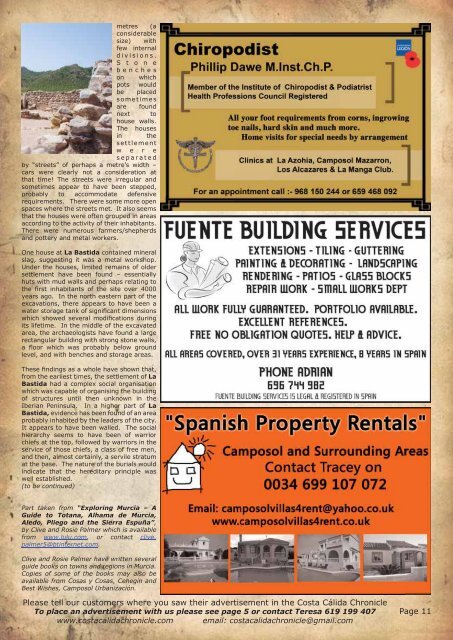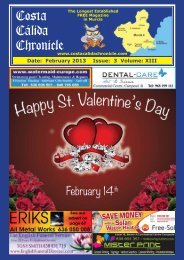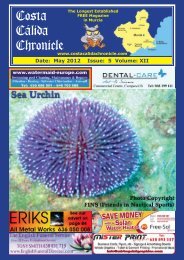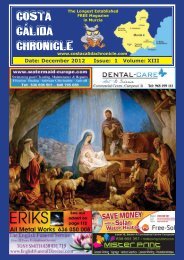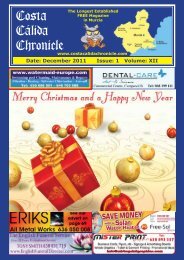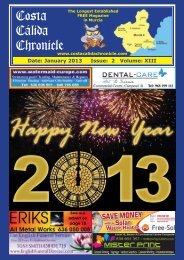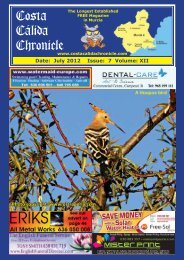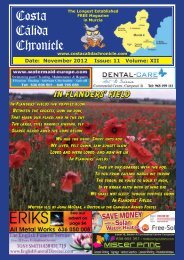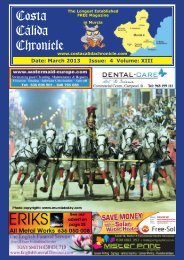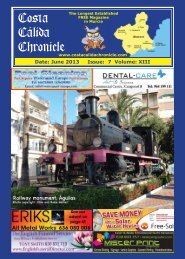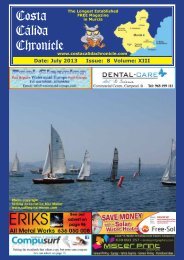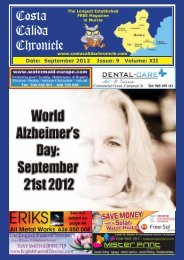Costa Cálida Chronicle - Costa Calida Chronicle
Costa Cálida Chronicle - Costa Calida Chronicle
Costa Cálida Chronicle - Costa Calida Chronicle
You also want an ePaper? Increase the reach of your titles
YUMPU automatically turns print PDFs into web optimized ePapers that Google loves.
metres (a<br />
considerable<br />
size) with<br />
few internal<br />
divisions.<br />
S t o n e<br />
benches<br />
on which<br />
pots would<br />
be placed<br />
sometimes<br />
are found<br />
next to<br />
house walls.<br />
The houses<br />
in the<br />
settlement<br />
w e r e<br />
separated<br />
by “streets” of perhaps a metre’s width –<br />
cars were clearly not a consideration at<br />
that time! The streets were irregular and<br />
sometimes appear to have been stepped,<br />
probably to accommodate defensive<br />
requirements. There were some more open<br />
spaces where the streets met. It also seems<br />
that the houses were often grouped in areas<br />
according to the activity of their inhabitants.<br />
There were numerous farmers/shepherds<br />
and pottery and metal workers.<br />
One house at La Bastida contained mineral<br />
slag, suggesting it was a metal workshop.<br />
Under the houses, limited remains of older<br />
settlement have been found – essentially<br />
huts with mud walls and perhaps relating to<br />
the first inhabitants of the site over 4000<br />
years ago. In the north eastern part of the<br />
excavations, there appears to have been a<br />
water storage tank of significant dimensions<br />
which showed several modifications during<br />
its lifetime. In the middle of the excavated<br />
area, the archaeologists have found a large<br />
rectangular building with strong stone walls,<br />
a floor which was probably below ground<br />
level, and with benches and storage areas.<br />
These findings as a whole have shown that,<br />
from the earliest times, the settlement of La<br />
Bastida had a complex social organisation<br />
which was capable of organising the building<br />
of structures until then unknown in the<br />
Iberian Peninsula. In a higher part of La<br />
Bastida, evidence has been found of an area<br />
probably inhabited by the leaders of the city.<br />
It appears to have been walled. The social<br />
hierarchy seems to have been of warrior<br />
chiefs at the top, followed by warriors in the<br />
service of those chiefs, a class of free men,<br />
and then, almost certainly, a servile stratum<br />
at the base. The nature of the burials would<br />
indicate that the hereditary principle was<br />
well established.<br />
(to be continued)<br />
Part taken from “Exploring Murcia – A<br />
Guide to Totana, Alhama de Murcia,<br />
Aledo, Pliego and the Sierra Espuña”,<br />
by Clive and Rosie Palmer which is available<br />
from www.lulu.com, or contact clive.<br />
palmer5@btinternet.com.<br />
Clive and Rosie Palmer have written several<br />
guide books on towns and regions in Murcia.<br />
Copies of some of the books may also be<br />
available from Cosas y Cosas, Cehegin and<br />
Best Wishes, Camposol Urbanización.<br />
Please tell our r customers s e s where you saw their e r advertisement v emen<br />
ent in the <strong>Costa</strong> Cálida á <strong>Chronicle</strong><br />
n To place an advertisement r em<br />
ent with us please e see page 5 or contact ct Teresa e esa 619 1999 407<br />
www.costacalidachronicle.com<br />
w.<br />
s a alid<br />
achr<br />
onic<br />
icle<br />
le.c<br />
om<br />
email: i : costacalidachronicle@gmail.com<br />
a alid<br />
achr<br />
onic<br />
icle<br />
le@g<br />
il.c<br />
om<br />
Page 11<br />
In association ation<br />
with <strong>Costa</strong> Cálida International ti<br />
na<br />
lRadi Radio and<br />
www.angloINFO.com<br />
w<br />
om


